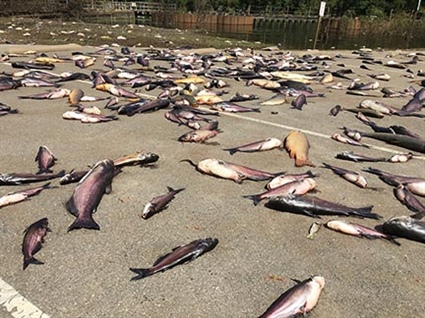
Numerous bodies of water still feeling impact of storm
Fisheries biologists with the N.C. Wildlife Resources Commission continue to document widespread fish kills in eastern North Carolina in the wake of Hurricane Florence.
The fish kills are the result of significant declines in dissolved oxygen. As of today, the rivers experiencing low dissolved oxygen levels and reported fish kills are:
Cape Fear River from Tar Heel to Southport
Sutton Lake near Wilmington
Northeast Cape Fear River from Kenansville to Wilmington
Black River from Garland to the Cape Fear River
South River from Garland to the Black River
Lumber River from Lumberton into South Carolina
Waccamaw River from the headwaters into South Carolina
Pungo River upstream of Belhaven
Neuse River from Goldsboro to Fort Barnwell
Contentnea Creek downstream of Hookerton
Trent River from Pleasant Hill downstream to the mouth at New Bern
White Oak River from the headwaters to Stella
Cashie River from Windsor to the mouth at Albemarle Sound
Roanoke River downstream of Highway 45 to the mouth at Albemarle Sound
Chowan River upstream of Winton
Many other rivers and streams, canals, lakes and private ponds in eastern North Carolina have also experienced dissolved oxygen declines and smaller, isolated fish kills.
As oxygen levels remain depressed, biologists expect the fish kills will persist for several more weeks.
“These fish kills, while unfortunate, are naturally occurring events that typically follow a major hurricane,” said Chad Thomas the Commission’s Coastal Region fishery supervisor. “Like we saw with Hurricane Irene in 2011 and Hurricane Isabel in 2003, low dissolved oxygen is the main culprit in these fish kills, rather than contaminants, pollution or other factors.”
Fish absorb oxygen from the water through their gills, and background oxygen levels of 5-6 ppm (parts per million) or higher are considered optimal for most species. Flood waters associated with Hurricane Florence inundated vast areas of swamp habitats that were naturally much lower in dissolved oxygen. As water levels recede, a flushing effect occurs. The result is a significant drop in dissolved oxygen in the mainstem rivers and creeks. When oxygen levels decline to 2 ppm, fish will become lethargic and often gasp at the surface.
“Many river basins have become anoxic, meaning they contain little if any dissolved oxygen,” Thomas said. “Numerous strandings of fish on roadways and adjacent to various water bodies have also been observed following substantial flooding.”
As water levels return to normal and water temperatures begin to cool, Thomas expects dissolved oxygen levels to gradually recover. Commission biologists will continue to monitor the affected water bodies through November to get a better understanding of the extent and severity of the fish kills. Next spring, they will sample the waters to determine fish species composition and abundance so they can determine strategies for recovery of fish stocks.
“These coastal systems are resilient, and with time, the fish populations in the impacted waters will recover, as they did after Hurricane Irene in 2011,” Thomas said.



